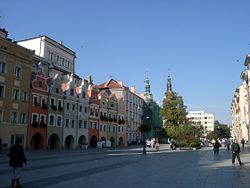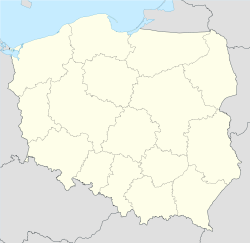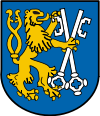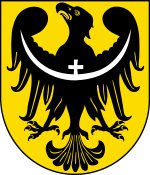Legnica
| Legnica | |||
 |
|||
|
|||
 Legnica
|
|||
| Coordinates: | |||
| Country | |||
|---|---|---|---|
| Voivodeship | Lower Silesian | ||
| County | city county | ||
| Established | 7th century | ||
| Town rights | 1264 | ||
| Government | |||
| - Mayor | Tadeusz Krzakowski | ||
| Area | |||
| - Total | 56.29 km² (21.7 sq mi) | ||
| Elevation | 113 m (371 ft) | ||
| Population (2006) | |||
| - Total | 105,485 | ||
| - Density | 1,874/km² (4,853.5/sq mi) | ||
| Time zone | CET (UTC+1) | ||
| - Summer (DST) | CEST (UTC+2) | ||
| Postal code | 59-200 to 59-220 | ||
| Area code(s) | +48 076 | ||
| Car plates | DL | ||
| Website: http://www.legnica.um.gov.pl | |||
Legnica [lɛgˈɲit͡sa] (![]() listen) (German: Liegnitz) is a city on the Kaczawa river in Lower Silesia in south-western Poland. According to official figures for 2006, it has a total population of 105,485.
listen) (German: Liegnitz) is a city on the Kaczawa river in Lower Silesia in south-western Poland. According to official figures for 2006, it has a total population of 105,485.
The city was formerly known in Polish as Lignica; it was officially renamed Legnica in 1946, after it had passed to Poland from Germany following World War II.[1]
Since 1999 Legnica has been part of Lower Silesian Voivodeship (from 1975 to 1998 it was the administrative seat of the former Legnica Voivodeship). The city constitutes a separate urban gmina and city county, as well as being the seat of Legnica County (which surrounds but does not include the city).
Contents |
History
The area of Legnica was at the intersection of travel routes of Celtic and East Germanic tribes. Tacitus in his Germania and Ptolemy recorded the Lugii (Lygii) in Magna Germania, and mentioned their town of Lugidunum, which has been attributed to both Legnica[2] and Głogów.[3] When the East Germanic tribes left for southern Europe, West Slavic tribes moved in and were the first group to settle it permanently.
The city was first officially mentioned in chronicles from 1004, although settlement dates to the 7th century. It was originally known as Lignica. It became the residence of the dukes of Lower Silesia in 1163, when the emperor granted ducal titles and liens to Silesian Dukes and was the seat of a principality ruled from 1248-1675. The Silesian dukes by the 17th century started to use an invented name "Silesian Piasts" and in 1847 a Polish historian for the first time wrote about a Piast Dynasty.
Legnica became famous for the Battle of Legnica (or Battle of Wahlstatt) that took place at Legnickie Pole near the city on 9 April 1241 during the Mongol invasion of Europe. The Christian army of the Polish duke Henry II the Pious of Silesia, supported by the feudal nobility, included Poles, Bavarian miners and military orders, was decisively defeated by the Mongols. Although the Mongols killed Henry and destroyed his forces, their advance into Europe was halted when they turned back to attend to the election of a new Khagan (Grand Khan) following the death in the same year of Ögedei Khan. Minor celebrations are held annually in Legnica to commemorate the battle.
As the capital of the Duchy of Legnica at the beginning of the 14th century, Legnica was one of the most important cities of Central Europe, having a population of approximately 16,000 residents. The city began to expand quickly after the discovery of gold in the Kaczawa River between Legnica and Złotoryja (Goldberg).
Legnica, along with other Silesian duchies, became a vassal of the Kingdom of Bohemia during the 14th century and was included within the Holy Roman Empire. The Protestant Reformation was introduced in the duchy as early as 1522 and the population became Lutheran. After the death of King Louis II of Hungary and Bohemia at Mohács in 1526, Legnica was inherited by the Habsburg Monarchy of Austria. The first map of Silesia was made by native son Martin Helwig. In 1676, Legnica passed to direct Habsburg rule after the death of the last Silesian Piast duke, Georg Wilhelm (son of Duke Christian of Brieg), despite the earlier inheritance pact by Brandenburg and Silesia, by which it was to go to Brandenburg. Silesian aristocracy was trained at the Liegnitz Ritter-Akademie.

In 1742 most of Silesia, including Liegnitz, became part of the Kingdom of Prussia after King Frederick the Great's defeat of Austria in the War of the Austrian Succession. In 1760 during the Seven Years' War, Liegnitz was the site of the Battle of Liegnitz when Frederick's army defeated an Austrian army led by Laudon. In 1813 during the Napoleonic Wars, the Prussians, under Field Marshal Blücher, defeated the French forces of MacDonald in the Battle of Katzbach nearby.
After the administrative reorganization of the Prussian state following the Congress of Vienna, Liegnitz and the surrounding territory (Landkreis Liegnitz) were incorporated into the Regierungsbezirk (administrative district) Liegnitz, within the Province of Silesia on 1 May 1816. Along with the rest of Prussia, the town became part of the German Empire in 1871 during the unification of Germany. On 1 January 1874 Liegnitz became the third city in Lower Silesia (after Breslau and Görlitz) to be raised to an urban district, although the district administrator of the surrounding Landkreis Liegnitz continued to have his seat in the city.

The census of 1910 gave Liegnitz's population as 95.86 % German, 0.15 % German and Polish, 1.27 % Polish, 2.26 % Wendish, and 0.19 % Czechs. On 1 April 1937 parts of the Landkreis Liegnitz communities of Alt Beckern, Groß Beckern, Hummel, Liegnitzer Vorwerke, Pfaffendorf und Prinkendorf were incorporated into the city of Liegnitz. After the Treaty of Versailles following World War I, Liegnitz was part of the newly created Province of Lower Silesia from 1919 to 1938, then of the Province of Silesia from 1938 to 1941, and again of the Province of Lower Silesia from 1941 to 1945.
After the defeat of Nazi Germany during World War II, Liegnitz and all of Silesia east of the Neisse river was transferred to Polish administration following the Potsdam Conference in 1945. The German population was expelled from between 1945 and 1947 and replaced with Poles and, as the medieval Polish name Lignica was considered archaic, the town was renamed Legnica. The transfer to Poland decided at Potsdam in 1945 was officially recognized by East Germany in 1950, by West Germany under Chancellor Willy Brandt in the Treaty of Warsaw signed in 1970, and finally by the reunited Germany by the Two Plus Four Agreement in 1990. By 1990 only a handful of Polonized Germans, pre-war citizens of Liegnitz, remained of the pre-1945 German population.
The city was only partly damaged in World War II. After 1965 most parts of the preserved old town with its precious town houses were demolished, the historical layout of a city was abolished and the city was rebuilt in modern forms.[4]
From 1945 to 1990, during the Cold War, the headquarters of the Soviet forces in Poland, the so-called Northern Group of Forces, was located in the city. This fact had a strong influence on the life of the city. For much of the period, the city was divided into Polish and Soviet areas, with the latter closed to the public. These were first established in July 1945, when the Soviets forcibly ejected newly arrived Polish inhabitants from the parts of the city they wanted for their own use. The ejection was perceived by some as a particularly brutal action, and rumours circulated exaggerating its severity, though no evidence of anyone being killed in the course of it has come to light. In April 1946 city officials estimated that they were 16,700 Poles, 12,800 Germans, and 60,000 Russians in Legnica.[5] The last Soviet units left the city in 1993.
In the 1950s and 1960s the local copper and nickel industries became a major factor in the economic development of the area.
Until the winter of 2003, the longest osobowy (standard railway train stopping at every station, in contrast to fast and express trains) train service in Poland ran from Katowice to Legnica (via Kędzierzyn-Koźle, Nysa, and Jaworzyna Śląska).
Economy
- Industry: copper mining and processing, KGHM Polska Miedź owns a large copper mill on the western outskirts of town.
- There is a Special Economic Zone in Legnica, where Lenovo will be opening a factory in summer 2008 [6].
Education
- state-run colleges and universities
- other
Twin towns
As of 2007, Legnica is twinned with five other European towns.
Environment
Legnica is noted for its parks and gardens, and has seven hundred hectares of green space, mostly along the banks of the Kaczawa river; the Tarninow district is particularly attractive. [7]
Important Roads
In the south of Legnica there are Highway—A4. Legnica has also a district, which is a part of country road no 3.
Public transport
Legnica has public transport. In city there are 20 normal bus lines, 1 belt-line, 2 night lines and 3 suburban.
The town has an airport (airport code EPLE) with a 1600-metre runway, the remains of a former Soviet air base, but it is (as of 2007) in a poor state and not used for commercial flights.
Sports
- Miedź Legnica - men's football team (Polish Cup winner 1992; 3rd league in seasons 2003/2004 and 2004/2005)
Politics
Municipal politics
Legnica tends to be a left-of-center town with a considerable influence of workers' unions. The Municipal Council of Legnica (Rada miejska miasta Legnica) is the legislative branch of the local government and is composed of 25 members elected in local elections every five years. The mayor or town president (Prezydent miasta) is the executive branch of the local government and is directly elected in the same municipal elections.
Legnica - Jelenia Góra constituency
Members of Parliament (Sejm) elected from Legnica-Jelenia Gora constituency:
- Ryszard Bonda, Samoobrona
- Bronisława Kowalska, SLD-UP
- Adam Lipiński, PiS
- Tadeusz Maćkała, PO
- Ryszard Maraszek, SLD-UP
- Olgierd Poniźnik, SLD-UP
- Władysław Rak, SLD-UP
- Tadeusz Samborski, PSL
- Jerzy Szmajdziński, SLD-UP
- Halina Szustak, LPR
- Michał Turkiewicz, SLD-UP
- Ryszard Zbrzyzny, SLD-UP .
Notable residents
- Henry II the Pious (1196/1207-1241), ruler of several duchies
- Witelo (1230-?), philosopher and scientist
- Bolesław II the Bald (1220-1278), ruler of several Polish duchies
- Jerzy Liban (1464-1546), composer and philologist
- Hans von Schweinichen (1552-1616), court steward
- Hans Aßmann Freiherr von Abschatz (1646-1699), lyricist and translator
- Christian Josef Willenberg (1676-1731), military engineer
- Georg Rudolf Böhmer (1723-1803), pharmacist and botanist
- Benjamin Bilse (1816-1902), conductor and composer
- Wilhelm Haberling (1871-1940), doctor and historian of medicine
- Paul Löbe (1875-1967), social democratic politician
- Horst Lange (1904-1971), author
- Erich von Manstein
- Günther Reich (1921-1989), opera singer
- Peter Marzinkowski (born 1939), first Bishop of Alindao
References
This article incorporates text translated from the corresponding German Wikipedia article as of July 27 2006.
- ↑ Information on history from the city's website
- ↑ Pierre Deschamps. Dictionnaire de géographie ancienne et moderne. Straubling & Müller, 1922.
- ↑ James Cowles Prichard. Researches Into the Physical History of Mankind. Sherwood, Gilbert, and Piper. London, 1841.
- ↑ Dehio - Handbuch der Kunstdenkmäler in Polen: Schlesien, Herder-Institut Marburg and Krajowy Osrodek Badan i Dokumentacji Zabytkow Warszawa, Deutscher Kunstverlag 2005, ISBN 342203109X, page 521.
- ↑ "ARMIA CZERWONA NA DOLNYM ŚLĄSKU" (in Polish). Institute of National Remembrance. Archived from the original on 2005-03-21.
- ↑ Lenovo to open big Polish PC factory - The INQUIRER
- ↑ Legnica: Welcome to Legnica
External links
- Map of Silesia with town of Li(e)gnitz in 1600
- Li(e)gnitz on HRE Germany map in 1600
- Municipal website (Polish)
- Lca.pl (Polish)
- City hall (Polish)
- Legnica (Polish)
|
||||||||||
|
|||||||



